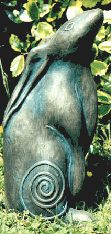 . . . [Norman Halkett] is one of the few people to have seen the mysterious circular assembly of hares. . . ."No one has ever been able to explain to me fully just why hares do on occasion sit in a wide circle with one or two or even more of their number having a gambols or frolics inside the circle. . . . I have seen it at least three times in my life, from as small a circle as say ten or twelve, to as many as thirty or forty hares, all performing at once. Some standing up . . . bolt upright on their hind-legs, others sitting on their hunkers, as we say, and some actually lying down as though they weren't paying much attention. But it does happen and I would honestly like to know what it really means."Image: MajorWildlife.co.uk via WonderfulWorldOfImages.com.
. . . [Norman Halkett] is one of the few people to have seen the mysterious circular assembly of hares. . . ."No one has ever been able to explain to me fully just why hares do on occasion sit in a wide circle with one or two or even more of their number having a gambols or frolics inside the circle. . . . I have seen it at least three times in my life, from as small a circle as say ten or twelve, to as many as thirty or forty hares, all performing at once. Some standing up . . . bolt upright on their hind-legs, others sitting on their hunkers, as we say, and some actually lying down as though they weren't paying much attention. But it does happen and I would honestly like to know what it really means."Image: MajorWildlife.co.uk via WonderfulWorldOfImages.com.
 Image: Subject and photographer unknown.
Image: Subject and photographer unknown.
Image: Subject and photographer unknown.
 Despite their reputation for rapid increase and hyper-sexuality, hares are not especially prolific breeders compared to rabbits – much less so compared to rodents. . . . But the brown hare does exhibit one extraordinary reproductive capacity which has provided, in the exaggerated descriptions given of it from Aristotle onwards, the basis for its reputation for unique and almost preternatural sexual proclivities and increase.Unlike most mammals, both female rabbits and hares will continue to mate while pregnant. But only the brown hare is capable of conceiving a second time – of carrying two potential litters at different stages of development. Superfetation, as it is called, can occur as a rare event in most mammals, even in humans. It has been recorded in populations of brown hares in up to 13 percent of females, a remarkably high and probably conservative figure. For Aristotle it was a primary characteristic of hares – and subsequent writers almost competed with each other to emphasize and exaggerate its miraculousness.
Despite their reputation for rapid increase and hyper-sexuality, hares are not especially prolific breeders compared to rabbits – much less so compared to rodents. . . . But the brown hare does exhibit one extraordinary reproductive capacity which has provided, in the exaggerated descriptions given of it from Aristotle onwards, the basis for its reputation for unique and almost preternatural sexual proclivities and increase.Unlike most mammals, both female rabbits and hares will continue to mate while pregnant. But only the brown hare is capable of conceiving a second time – of carrying two potential litters at different stages of development. Superfetation, as it is called, can occur as a rare event in most mammals, even in humans. It has been recorded in populations of brown hares in up to 13 percent of females, a remarkably high and probably conservative figure. For Aristotle it was a primary characteristic of hares – and subsequent writers almost competed with each other to emphasize and exaggerate its miraculousness.– Simon CarnellHare
pp. 34-35























